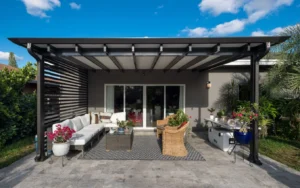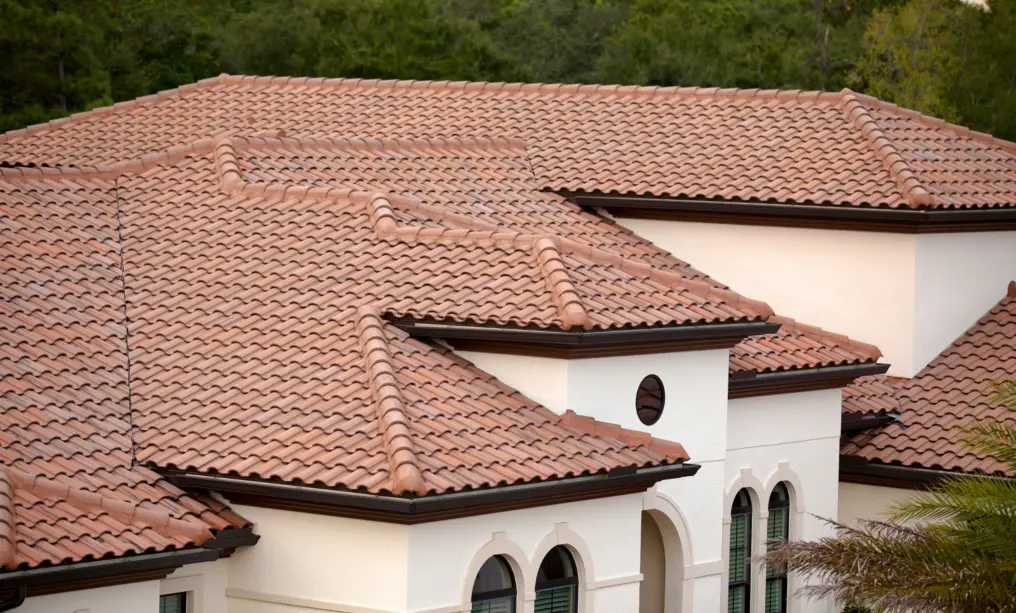How to Build Metal Roof Covered Patio?
Oct 06, 2025
If you’ve been wondering how to build metal roof covered patio that’s both durable and attractive, you’re in the right place. While a DIY approach might seem appealing, the process can quickly get complicated—especially if you want it to withstand Florida’s intense sun, rain, and hurricanes. That’s why many homeowners in Venice turn to Florida Roofing and Gutters, the trusted local experts in metal roofing and patio projects across Southwest Florida.
Before you start slicing metal panels or sizing support beams, it’s crucial to keep a few things in mind so that the project is done safely and correctly and stays within any local codes and regulations. Here’s what you need to know when it comes to building a durable, stylish and long-lasting metal roof patio.
Key Takeaways
- Creating a covered patio with metal roof requires lots of not to mention good amount of effort and planning.
- The best materials for Florida’s climate are aluminum, steel, and galvanized metal.
- Leaks and structural problems can occur when the framing is not done properly or when the unit isn’t sealed well.
- Having it professionally installed can provide you with peace of mind that it is safe, secure and code-compliant.
- Installation of Metal Roofing and Patios in Venice by the Experts at Florida Roofing and Gutters.
Book Your FREE Inspection Today!
Step 1: Plan the Patio Route and Size
Let’s keep it real — before you get out any tools, and you’ve come up with a plan on how to build metal roof covered patio. The very first and the step in how to construct a Metal Roof Covered Patio is identifying its size, location and design of the patio. Ask yourself:
- Do you want it connected to your house or a freestanding building?
- How much shade do you need?
- For what will the patio be used — dining alfresco, lounging or grilling?
Draw your design out in a sketch or consult someone who can draw one to scale. It’s also wise to consult with your local building department in Venice for any necessary permits or zoning requirements. Florida also has very strict wind-load codes, particularly in the coastal regions, and so you will have to design the building to meet that standard.
Step 2: Select the Best Metal for Your Roofing Application
This part can make or break your project. The type of metal you choose will not only affect the look of your patio, but also how long it lasts.
Here’s what that typically looks like:
- Aluminum: Lightweight, rust-proof and perfect for Florida humidity.
- Steel: Durable and risk-resistant, ideal for large patios or heavy rains.
- Galvanized Steel: Inexpensive and durable, though it might need to be painted to avoid rusting.
And a shiny or light-colored surface will also lower heat gain — key for Venice’s hot summers. Much of the time, Florida Roofing and Gutters may suggest a metal panel with high reflectance, having an energy-efficient product that offers a high UV protection.
Step 3: Build the Frame
The frame is the mechanism holding everything together, so it has to be robust. Install pressure-treated wooden or steel posts that are securely planted in the ground or concrete-filled.
Attached patios should have the ledger board connecting the structure to your house fully sealed and tightly reinforced. If you are building a freestanding structure, space your posts equally and support weight with crossbeams.
When you’re deciding how to build metal roof overhangs, don’t ever forget: Reinforcement is never an option. When you live in storm-prone Southwest Florida, connecting the roof to the walls with diagonal bracing or hurricane ties is vital.
Step 4: Install the Roof Panels
This is where it counts the most. Begin by measuring and cutting your metal sheets to the size of the patio. Panel overlap is to be a minimum of one (1) ridge of the profile and use rubber-sealed screws to prevent any back flow of water.
If you are using corrugated metal, run the slots perpendicular to the frame’s beams for improved drainage performance. Ensure every fastener is correctly torqued: too loose and the roof rattles, too tight and the panels may become damaged.
To get installation done right, leave it to the experts at Florida Roofing and Gutters! Their professional roofers understand how to install panels, flashings and sealants that will endure Florida’s coastal weather.
Step 5: Add Gutters and Some Finishing Touches
A metal roof patio would be nothing without some drainage. Include gutters and downspouts to funnel water away from the patio space. This would prevent puddles, erosion and nearby landscaping damage.
You could also complete the project with ceiling fans, recessed lighting or even a skylight for natural light. Just be sure that any electrical work is up to your local code.
When you need a finished look that’s free from leaks and lasts for years, you can count on expertise from a reputable roofing company like Florida Roofing and Gutters to get the job done. Their specialty is incorporating the gutters and waterproofing systems with all metal roofing work.

Book Your FREE Inspection Today!
The Advantage of a Metal Roof Patio Cover
So why do homeowners throughout Venice adore metal roof patios, anyway?
- Lifespan: In moist, hurricane-prone areas, metal roofing should last 40–70 years.
- Low Upkeep: They do not decompose or fall to mold and/or bugs.
- Energy Efficiency: Block out sunlight and make your patio space cooler.
- Stylish: Goes great with contemporary or beach homes.
Enhanced Property Value Open-and-close convenience adds new functionality and visibility to any home.
Metal patios are more than just a pretty face—they make sense for Florida homes.
DIY vs. Professional Installation
Yes, you could go the DIY route, but mistakes with metal roofing are expensive. Poor installation typically results in leaks, buckling panels, or even roof collapse during adverse weather.
When you turn to professionals, such as Florida Roofing and Gutters, make no mistake – you’re not just paying for labor; you’re making an investment in experience. Their in-house team takes care of everything from measurements and permits through final inspection. And they make sure your patio will pass muster with local codes and insurance requirements.
If you want peace of mind and enduring results, professional help is worth every penny.
Common Mistakes to Avoid
If you decide to make one yourself, avoid these mistakes:
- The frame made of untreated lumber will decompose quickly in the humidity.
- No flashing or sealant between roof joints.
- Ignoring proper drainage systems.
- Overlooking wind resistance ratings.
- Neglecting to secure permits or adhere to local building codes.
Do keep in mind that even a small error can result thousands of dollars worth of work down the line.
Conclusion
Like any large home improvement project though, you’ll want to get things right first time around. Building a metal roof over patio certainly adds comfort, value and style to your property; however, it is challenging undertaking. Everything from planning and permitting to installation and finishing work needs to be precise. If you’re not a professional and if you are questioning “how to build metal roof covered patio” then it may be best to leave it up to the professionals at Florida Roofing and Gutters.
With more than 30 years of experience working with homeowners in Venice, as well as throughout Southwest Florida, they bring the utmost professionalism to every job and use only the highest quality products and materials.
Don’t hesitate to call us at Florida Roofing and Gutters today, and we will schedule your consultation so that you can have your dream metal patio realized with confidence.
Book Your FREE Inspection Today!
Frequently Asked Questions
1. How long does it take to build a metal roof covered patio?
Typically, 3–7 days depending on size, design, and weather conditions. Professional crews can complete the job faster and more safely.
2. What’s the best metal for patios in Florida?
Aluminum or galvanized steel—both resist corrosion and perform well in humid, coastal environments.
3. Do I need a permit to build a patio roof in Venice, FL?
Yes, most areas in Southwest Florida require permits for structural projects like patios or roof extensions.
4. Can I attach a metal patio roof directly to my house?
Yes, but you need proper flashing and waterproofing to prevent leaks between the patio and main roof.
5. How much does it cost to build a metal roof patio?
Prices vary by size and materials, but professional installations in Florida typically range from $3,000–$10,000.

